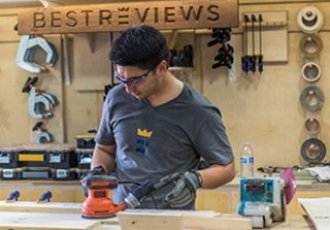BestReviews is reader-supported and may earn an affiliate commission. Details
We recommend these products based on an intensive research process that's designed to cut through the noise and find the top products in this space. Guided by experts, we spend hours looking into the factors that matter, to bring you these selections.

If you own a woodworking or metalworking lathe, a live center is an essential accessory. It prevents overheating of the workpiece (which can burn wood) and reduces wear so your work will be more accurate. It’s also a good deal quieter than having a dead center squealing away at hundreds of revolutions per minute!
At a glance, live centers seem straightforward, but while the principle is the same, there are considerable differences among them. With prices ranging from under $20 to over $600, it’s helpful to know what you’re looking for.

If you have a lathe, there’s a better than even chance it came with a dead center for the tailstock. These are serviceable, but a live center is much better. The main difference is simply a set of bearings that enable the point to rotate when the workpiece does. However, as with most tools, lots of variations have been developed to suit different purposes.
The sizing system, called a Morse taper, ensures the live center will fit your machine. All you have to do is match the numbers, which are expressed as either # or MT. For example, #2 and MT2 are the same thing. In theory, Morse tapers go from MT0 to MT7 (higher numbers are larger), though in practice MT1, MT2, and MT3 are by far the most common.

Woodworking: To be honest, woodworkers can get by with just about any live center that fits their lathe. Workpieces aren’t often very heavy, and the turning speeds are relatively modest. Cheap live centers will do the job, but we’d recommend investing in quality, say $30 to $60, for durability and accuracy.
The live center should be hardened steel, and the best give you a Rockwell number (such as Rc 60) which shows it has achieved an international testing standard. You may eventually want different tips for specific tasks (longer, narrower ends for small diameters, for example), but you can’t really go wrong.
Metalworking: This can involve much heavier workpieces and much, much faster rotation, so it’s important to find the right solution. If you don’t, precision will suffer and safety could be compromised.

Weight: You’ll find that metalworking live centers have ratings for maximum workpiece weight and maximum speed. If you see one that doesn’t offer this detail, look elsewhere. You don’t want to encounter problems with a lump of steel that weighs a couple of pounds spinning at 10,000 revolutions per minute.
Accuracy: You may also get a figure for accuracy or concentricity: how much the point moves as it rotates. This can be tiny amounts, the equivalent of a tenth the thickness of a human hair, but sometimes engineering demands these tolerances. Live centers designed for CNC lathes are usually described as such.
For metalworking purposes, you have a much wider range of tips. There are live centers designed to go inside tubular steel, for example, and even those that are spring-loaded so they can take into account expansion as the metal gets hotter. A basic 60° tip is adequate for a multitude of uses, but there will be times when you need something more specialized, so more research will be needed.

A. We’d say almost always! Although rare, there are occasions when you might use a dead center instead. If you’ve got a workpiece you can’t mount in a chuck, you might use one in the headstock end for drive, with a live center in the tailstock. Equally, live centers tend to be a bit bulky, so if you’re working on something small, you might need a dead center so you can get the tool to the workpiece. If you do use one, good lubrication is absolutely vital.
A. It depends on the type of tailstock. If it can be wound in and out (has a wheel on the back), then you retract the quill (the inner sleeve) until the center pops out. If it’s fixed, you tap it out, either with a small rod pushed through the back end of the tailstock or via a slot in the side, using an angled piece of metal called a “drift.” Despite the incredibly strong grip that a Morse taper provides, a light tap with a hammer will free it.
A. Computer numerical control. It allows software to control machine tools with an incredible amount of accuracy — to 1/10,000 of an inch. It’s mostly used in metalworking for drills, lathes, and milling machines; in woodwork it’s only used for CNC routers.
Get emails you’ll love.
Learn about the products you’re wondering if you should buy and get advice on using your latest purchases.
